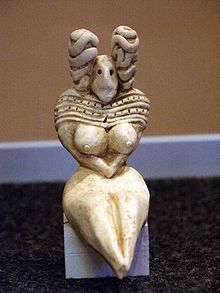Prehistoric times
The history of Pakistan is the history of humanity itself. The land of Pakistan stands witness to the early journey of human beings (and other related hominin species) out of Africa. It is a well-established fact that the early migrations of archaic and modern humans out of Africa began nearly 1.8 million years ago − the earliest of which was the exodus of Homo erectus into the Middle East and Asia. A careful study of the human fossils and stone-age artefacts reveal the story of these early migrations of hominini into South Asia and Pakistan.
Early hominin migration
[edit | edit source]Early palaeolithic settlements
[edit | edit source]Some of the key sites for this early migration out of Africa are Riwat in Pakistan,[1] Ubeidiya in the Levant and Dmanisi in the Caucasus.[2] These early hominini lived in a hunter-gatherer society and utilised fire. They were the first hominin species that lived in small band-societies, hunted in coordinated groups, used complex tools and cared for their weak companions. There is ample evidence suggesting that some of these early hunter-gatherers settled in what are now the Sivalik regions of Pakistan.
From hunter-gatherers to farmers
[edit | edit source]
The earliest evidence of food processing in the region comes from tools and implements found at Mehrgarh in the Balochistan province of Pakistan. Mehrgarh is one of the most important Neolithic sites in archaeology. It is regarded as one of the earliest sites with evidence of farming and herding in South Asia.
Early farming and herding
[edit | edit source]The semi-nomadic people that came to occupy this land used plants such as wheat and barley and animals such as sheep, goats and cattle. Their settlements were established with simple mud buildings and most of them had four internal subdivisions. Numerous burials have been found, many with elaborate goods such as baskets, stone and bone tools, beads, bangles, pendants and occasionally animal sacrifices, with more goods left with burials of males.
Neolithic proto-dentistry
[edit | edit source]In 2001, archaeologists studying the remains of two men from Mehrgarh made the discovery that the people of the Indus Valley Civilization, from the early Harappan periods, had knowledge of proto-dentistry. Subsequently, in April 2006, it was announced in the scientific journal Nature that the oldest (and first early Neolithic) evidence for the drilling of human teeth in vivo (i.e. in a living person) was found in Mehrgarh.[3]
The cradle of civilisation
[edit | edit source]The notion of prehistory is often derived from the knowledge of society and places reaching an advanced stage of social development and organisation, which is often encompassed in a broader sense by the word ‘civilisation’. Prehistoric Pakistan has been a host to one such remarkable civilisation − the Indus Valley Civilisation.
The Indus Valley Civilisation is one of the oldest known human civilisations and was a contemporary of the ancient Mesopotamian and Egyptian civilisations. It is also one of the first human civilisations to use writing as a form of communication where pictographic writing commenced as early as 3,000 BCE.[4]
Citations
[edit | edit source]- ↑ Fleagle et al. (2010)
- ↑ Garcia et al. (2010)
- ↑ Coppa et al. (2006): Flint tips were surprisingly effective for drilling tooth enamel in a prehistoric population ... eleven drilled molar crowns from nine adults discovered in a Neolithic graveyard in Pakistan that dates from 7,500–9,000 years ago.
- ↑ Bellwood & Ness (2014, p. 224): "Pictographic writing had commenced by 3000 BCE in the Middle East, including Mesopotamia, Egypt, and Pakistan, by 1500 BCE in China, and by 100 BCE amongst the Mayas of Mesoamerica."
References
[edit | edit source]- Bellwood, Peter; Ness, Immanuel (2014). The Global Prehistory of Human Migration. John Wiley & Sons. ISBN 9781118970591.
{{cite book}}: Invalid|ref=harv(help) - Fleagle, J.G.; Shea, J.J.; Grine, F.E.; Baden, A.L.; Leakey, R.E., eds. (2010). "Out of Africa I: The First Hominin Colonization of Eurasia". Vertebrate Paleobiology and Paleoanthropology. Springer Netherlands. ISBN 9789400733084. ISSN 1877-9077.
{{cite web}}: Invalid|ref=harv(help) - Garcia, T.; Féraud, G.; Falguères, C.; de Lumley, H.; Perrenoud, C.; Lordkipanidze, D. (2010). "Earliest human remains in Eurasia: New 40Ar/39Ar dating of the Dmanisi hominid-bearing levels, Georgia". Quaternary Geochronology. 5 (4): 443–451. doi:10.1016/j.quageo.2009.09.012.
- Coppa, A.; Bondioli, L.; Cucina, A.; Frayer, D.W.; Jarrige, C.; Jarrige, J.-F.; Quivron, G.; Rossi, M.; Vidale, M.; Macchiarelli, R. (6 April 2006). "Early Neolithic tradition of dentistry" (PDF). Nature. 440: 755–756. doi:10.1038/440755a.
{{cite journal}}: Invalid|ref=harv(help)CS1 maint: date and year (link)